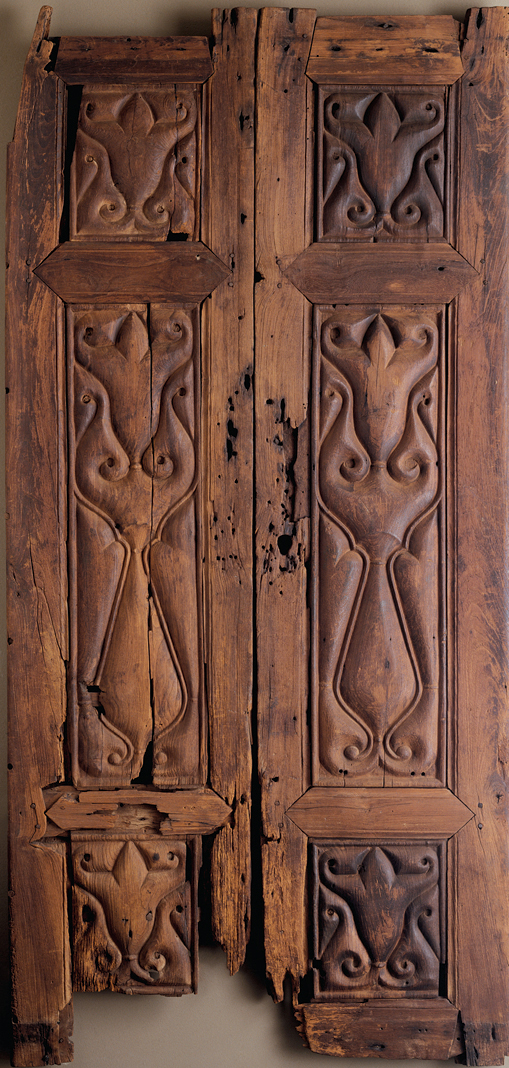A History of World Societies:
Printed Page 242
A History of World Societies Value
Edition: Printed Page 240
Chapter Chronology
The Abbasid Caliphate

Abbasid Wooden Doors These ninth-century wooden doors are thought to come from Samarra, a city about 125 miles upstream from Baghdad, which briefly served as the capital in the ninth century. (Doors, pair, Abbasid Period, 9th century. Carved wood. Fletcher Fund, 1931 [31.119.1.2] [31.119.1, 31.119.2]. Photo: Schecter Lee/The Metropolitan Museum of Art, New York, NY, USA/Image copyright © The Metropolitan Museum of Art/Image source: Art Resource, NY)
In 747 the Abbasid leader Abu’ al-Abbas led a rebellion against the Umayyads, and in 750 he won general recognition as caliph. Damascus had served as the headquarters of Umayyad rule. Abu’ al-Abbas’s successor, al-Mansur (r. 754–775), founded the city of Baghdad in 762 and made it his capital. Thus the geographical center of the caliphate shifted eastward to former Sassanid territories. The first three Abbasid caliphs crushed their opponents, turned against many of their supporters, and created a new ruling elite drawn from newly converted Persian families that had traditionally served the ruler. The Abbasid revolution established a basis for rule and citizenship more cosmopolitan and Islamic than the narrow, elitist, and Arab basis that had characterized Umayyad government.
The Abbasids worked to identify their rule with Islam. They patronized the ulama, built mosques, and supported the development of Islamic scholarship. Although at first Muslims represented only a small minority of the conquered peoples, Abbasid rule provided the religious-political milieu in which Islam gained, over time, the allegiance of the vast majority of the populations from Spain to Afghanistan.
The Abbasids also borrowed heavily from Persian culture. Following Persian tradition, the Abbasid caliphs claimed to rule by divine right, as reflected in the change of their title from “successor of the Prophet” to “deputy of God.” A majestic palace with hundreds of attendants and elaborate court ceremonies deliberately isolated the caliph from the people he ruled. Subjects had to bow before the caliph and kiss the ground, symbolizing his absolute power.
Under the third caliph, Harun al-Rashid (r. 786–809), Baghdad emerged as a flourishing commercial, artistic, and scientific center — the greatest city in Islam and one of the most cosmopolitan cities in the world. Its population of about a million people — an astoundingly large size for preindustrial times — created a huge demand for goods and services, and Baghdad became an entrepôt (trading center) for textiles, slaves, and foodstuffs coming from Oman, East Africa, and India. The city also became intellectually influential. Harun al-Rashid organized the translation of Greek medical and philosophical texts. As part of this effort the Christian scholar Hunayn Ibn Ishaq (808–873) translated Galen’s medical works into Arabic and made Baghdad a center for the study and practice of medicine. Likewise, impetus was given to the study of astronomy, and through a program of astronomical observations, Muslim astronomers sought to correct and complement Ptolemaic astronomy, which held that the earth is a stationary object at the center of the universe. Above all, studies in Qur’anic textual analysis, history, poetry, law, and philosophy — all in Arabic — reflected the development of a distinctly Islamic literary and scientific culture.
An important innovation of the Abbasids was the use of slaves as soldiers. The caliph al-Mu’taşim (r. 833–842) acquired several thousand Turkish slaves who were converted to Islam and employed in military service. Scholars have offered varied explanations for this practice: that the use of slave soldiers was a response to a manpower shortage; that as highly skilled horsemen, the Turks had military skills superior to those of the Arabs and other peoples; and that al-Mu’taşim felt he could trust the Turks more than the Arabs, Persians, Khurasans, and other recruits. In any case, slave soldiers — later including Slavs, Indians, and sub-Saharan blacks — became a standard feature of Muslim armies in the Middle East until the twentieth century.
